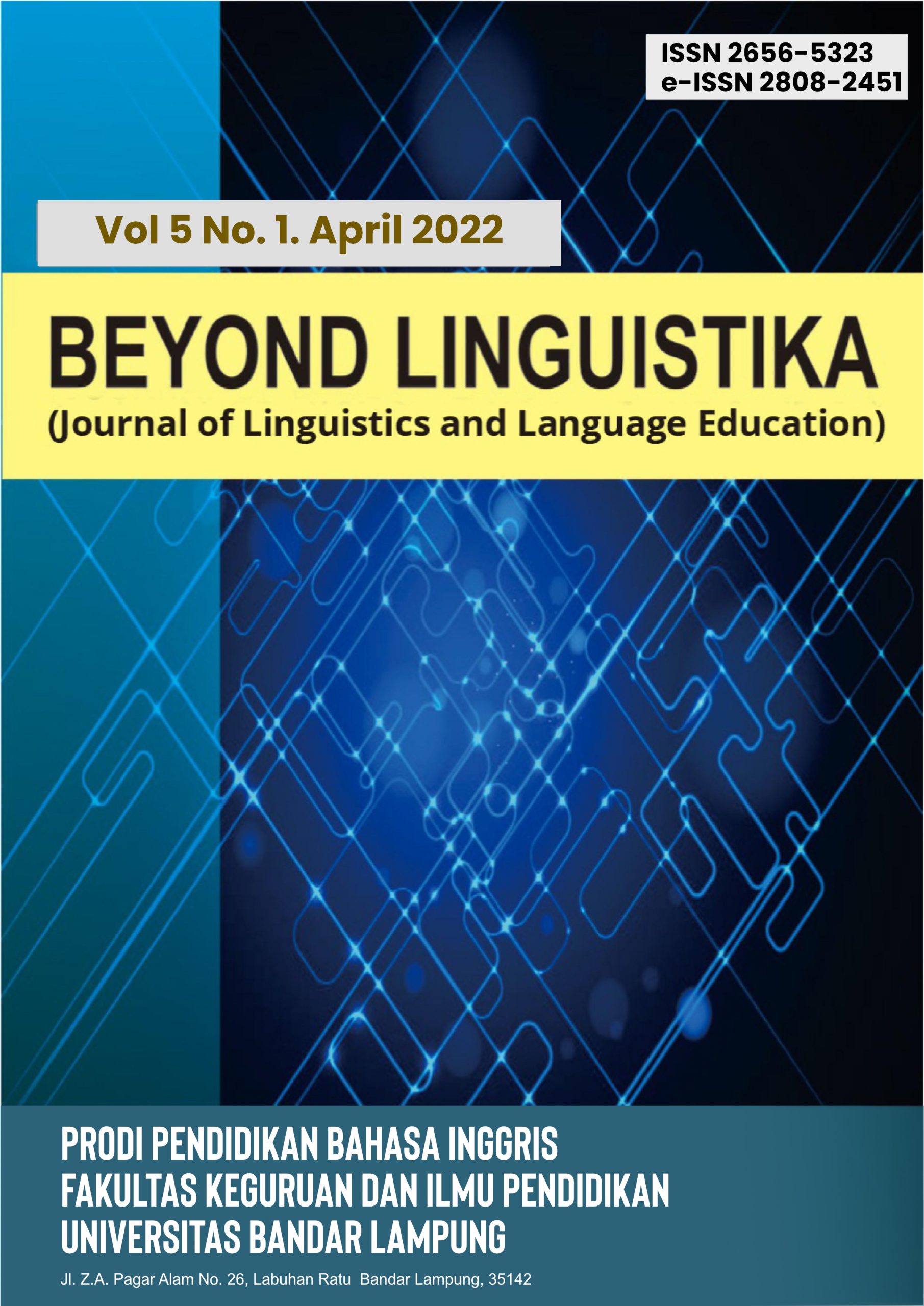Translanguaging Practices in The English Zone: Enhancing Speaking Skills at SMA Irsyaadul Ibaad Islamic Boarding School
Abstract
This study aims to explore the communication practices of students within the English language zone at SMA Irsyaadul Ibaad Islamic Boarding School, focusing on the utilization of translanguaging as a strategy to enhance their speaking skills. The research questions guiding this investigation include examining the role of language translation in students' communicative repertoire, assessing the impact of translanguaging practices on the development of students' English speaking skills, and investigating students' perceptions and experiences with translanguaging in the English zone. The research methodology employs qualitative approaches, such as interviews, observation, and documentation, to collect data. The findings indicate that translanguaging techniques within the English zone significantly contribute to students' growth in speaking skills, leading to improved fluency, confidence, and the ability to engage in conversations. This study highlights the importance of creating a dynamic and inclusive language learning environment by leveraging students' linguistic resources through translanguaging practices. The implications of these findings suggest that promoting translanguaging can enhance English language proficiency, cultivate positive attitudes towards language learning, boost self-confidence, and foster a supportive community of learners within the school setting.
Keywords
Full Text:
PDFReferences
Adams, B. L. (2020). How English-Speaking Teachers Can Create a Welcoming Environment that Allows Students to Maintain and Utilize their Language through Translanguaging: A Qualitative Case Study. Journal of Culture and Values in Education, 3(2), 196–211. https://doi.org/10.46303/jcve.2020.20
Allard, E. C. (2017). Re-examining teacher translanguaging: An ecological perspective. Bilingual Research Journal, 40(2), 116–130. https://doi.org/10.1080/15235882.2017.1306597
Canagarajah, S. (2011). Codemeshing in Academic Writing: Identifying Teachable Strategies of Translanguaging. The Modern Language Journal, 95(3), 401–417.
Cenoz, J. (2017). Translanguaging in School Contexts: International Perspectives. Journal of Language, Identity & Education, 16(4), 193–198. https://doi.org/10.1080/15348458.2017.1327816
Christiansen, M. S. (2017). Language use in social network sites: The influence of orality in the digital writing of Mexican bilinguals. . Writing and Pedagogy, 9(2), 369–392. https://doi.org/https://doi.org/10.1558/wap.30281
Creese, A., & Blackledge, A. (2015). Translanguaging and Identity in Educational Settings. Annual Review of Applied Linguistics, 35, 20–35. https://doi.org/DOI: 10.1017/S0267190514000233
Darmajanti, P. (2020). Increasing Communicative Competence for New Challenges and Opportunities of Industry 4.0. Proceedings of the First International Conference on Applied Science and Technology (ICAST 2018), 40–43. https://doi.org/10.2991/assehr.k.200813.010
Duarte, J. (2020). Translanguaging in the context of mainstream multilingual education. International Journal of Multilingualism, 17(2), 232–247. https://doi.org/10.1080/14790718.2018.1512607
Hasanah, D., & Wirza, Y. (2021). Students’ Identity in Multicultural Education: Reflection on Communication Practice. Proceedings of the Thirteenth Conference on Applied Linguistics (CONAPLIN 2020), 107–113. https://doi.org/10.2991/assehr.k.210427.017
King, K., Fogle, L., & Logan-Terry, A. (2008). Family language policy. Linguistics and Language Compass, 2(5), 907–922. https://doi.org/https://doi.org/10.1111/j.1749-818X.2008.00076.x
Kusuma, E. D., Dharmawan, Y. Y., Oktariani S., A. I., & Mawuntu, S. C. (2023). Analysis of Translingual Practices:A Case Study of Indonesia Teenagers’ Instagram Users. Dialectical Literature and Educational Journal, 8(2), 45–57. https://doi.org/https://doi.org/10.51714/dlejpancasakti.v8i2.101.pp.45-57
Leonet, O., Cenoz, J., & Gorter, D. (2017). Challenging Minority Language Isolation: Translanguaging in a Trilingual School in the Basque Country. Journal of Language, Identity & Education, 16(4), 216–227. https://doi.org/10.1080/15348458.2017.1328281
Lin, A. M. Y., & He, P. (2017). Translanguaging as Dynamic Activity Flows in CLIL Classrooms. Journal of Language, Identity & Education, 16(4), 228–244. https://doi.org/10.1080/15348458.2017.1328283
Liu, Y., & Fang, F. (2020). Translanguaging Theory and Practice: How Stakeholders Perceive Translanguaging as a Practical Theory of Language. RELC Journal, 53(2), 391–399. https://doi.org/10.1177/0033688220939222
Loureiro-Rodriguez, V., Boggess, M. M., & Goldsmith, A. (2013). Language attitudes in Galicia: using the matched-guise test among high school students. Journal of Multilingual and Multicultural Development, 34(2), 136–153. https://doi.org/10.1080/01434632.2012.729591
Makalela, L. (2015). Moving out of linguistic boxes: the effects of translanguaging strategies for multilingual classrooms. Language and Education, 29(3), 200–217. https://doi.org/10.1080/09500782.2014.994524
Masuram, J., & Sripada, P. N. (2020). Developing Speaking Skills Through Task-Based Materials. Procedia Computer Science, 172, 60–65. https://doi.org/https://doi.org/10.1016/j.procs.2020.05.009
Ngubane, N., Ntombela, B. X., & Govender, S. (2020). Translanguaging pedagogy in selected English First Additional Language writing classrooms. Southern African Linguistics and Applied Language Studies, 38(2), 142–151. https://doi.org/10.2989/16073614.2020.1771190
Nyimbili, F., & Mwanza, D. S. (2021). Translanguaging Challenges faced by Teachers and Learners in First Grade Multilingual Literacy Classrooms in Zambia. International Journal on Studies in English Language and Literature, 9(3), 20–31. https://doi.org/10.20431/2347-3134.0903003
Oxford, R. L., Holloway, M. E., & Horton-Murillo, D. (1992). Language learning styles: Research and practical considerations for teaching in the multicultural tertiary ESL/EFL classroom. System, 20(4), 439–456. https://doi.org/https://doi.org/10.1016/0346-251X(92)90057-A
Pánchez-Jiménez, T. (2021). The use of TransLanguage to improve oral reading proficiency in a foreign language classroom. Cátedra, 4(3), 57–73. https://doi.org/10.29166/catedra.v4i3.3041
Pek, Y. (2017). Translanguaging with multilingual students. Learning from classroom moments, edited by Ofelia García and Tatyana Kleyn. Pedagogies: An International Journal, 12(4), 410–413. https://doi.org/10.1080/1554480X.2017.1379269
Rajendram, S. (2023). Translanguaging as an agentive pedagogy for multilingual learners: affordances and constraints. International Journal of Multilingualism, 20(2), 595–622. https://doi.org/10.1080/14790718.2021.1898619
Rao, P. S. (2019). The importance of speaking skills in English classrooms. Alford Council of International English & Literature Journal(ACIELJ), 2(2), 6–18. www.acielj.com
Rivera, A. J., & Mazak, C. (2017). Pedagogical Translanguaging in a Puerto Rican University Classroom: An Exploratory Case Study of Student Beliefs and Practices. Journal of Hispanic Higher Education, 18(3), 225–239. https://doi.org/10.1177/1538192717734288
Sabina, Z. (2018). The Importance of Teaching Listening and Speaking Skills. World Science, 7(6(34)), 52–55. https://doi.org/10.31435/rsglobal_ws/12062018/5881
Velasco, P., & García, O. (2014). Translanguaging and the Writing of Bilingual Learners. Bilingual Research Journal, 37(1), 6–23. https://doi.org/10.1080/15235882.2014.893270
Vogel, S., & Garcia, O. (2017). Translanguaging. Oxford Research Encyclopedia of Education, 1–21.
Wang, P. (2021). A case study of translanguaging phenomenon in CBI classes in a Chinese university context. International Journal of Applied Linguistics, 31(1), 95–108. https://doi.org/https://doi.org/10.1111/ijal.12324
Wong, K. M. (2018). C. M. Mazak and K. S. Carroll (Eds): Translanguaging in Higher Education: Beyond Monolingual Ideologies. Applied Linguistics, 39(3), 434–441. https://doi.org/10.1093/applin/amx032
Yaccob, N. S., Yunus, M. M., & Hashim, H. (2022). The Integration of Global Competence Into Malaysian English as a Second Language Lessons for Quality Education (Fourth United Nations Sustainable Development Goal). In Frontiers in Psychology (Vol. 13). Frontiers Media S.A. https://doi.org/10.3389/fpsyg.2022.848417
Yuan, R., & Yang, M. (2020). Towards an understanding of translanguaging in EMI teacher education classrooms. Language Teaching Research, 27(4), 884–906. https://doi.org/10.1177/1362168820964123
DOI: http://dx.doi.org/10.36448/bl.v6i2.3582
Refbacks
- There are currently no refbacks.















